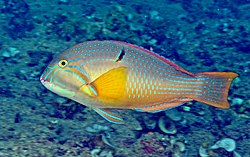Top Qs
Timeline
Chat
Perspective
Hypsigenyinae
Subfamily of ray-finned fishes From Wikipedia, the free encyclopedia
Remove ads
The hypsigenyine wrasses are saltwater fish of the subfamily Hypsigenyinae, a subgroup of the wrasse family (Labridae).[1] The group is circumglobal, being found in almost all the of world's shallow tropical marine waters, although some species are also found in temperate zones.[2]
Remove ads
Taxonomy
Summarize
Perspective
Hypsigenyinae is the sister group to all other wrasse subfamilies. The group was first proposed in 1997. Since then, molecular phylogenetics has found that it also includes odacines and the genus Pseudodax. Odacines were once considered to be their own taxonomic family, but have been found nested deep within the hypsigenyine wrasses, and are the sister group to the hypsigenyine genus Choerodon.[2][3] Odacines remain a monophyletic group however.[3][4] Pseudodax was once considered to be the closest relative to parrotfish (tribe Scarini), but is now considered a basal hypsigenyine.[2]
Westneat & Alfaro (2005) and Hughes et al (2022) found that the hogfish (Lachnolaimus maximus) is the sister group to all other hypsigenyine wrasses. However, neither study examined the natal wrasse (Anchichoerops natalensis),[2][3] which was recovered as the actual sister group to all other hypsigenyine wrasses by Balwin et al (2023).[5]

Hypsigenyine wrasses exhibit several ancestral features shared with perciforms, but were subsequently lost in more derived wrasses. One example is the presence of vomerine teeth.[2] Hypsigenyine wrasses also have a derived trait, which is phyllodont dentition of the pharyngeal teeth, ie, these teeth develop stacked on top of each other, with only the uppermost teeth in the stack emerging.[6]
Unlike most wrasse groups, hypsigenyines are well-represented in the fossil record. The Italian fossil wrasse †Phyllopharyngodon is strongly supported to be a hypsigenyine because it exhibits phyllodont pharyngeal teeth like other members of the tribe,[6] and is about 50 million years old, dating to the Eocene.[2] The fossil genera Labrodon and Trigonodon are abundant in the Miocene of Europe.[7]
Remove ads
Genera
Remove ads
References
Wikiwand - on
Seamless Wikipedia browsing. On steroids.
Remove ads
















